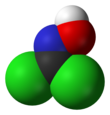Phosgene oxime
| |||
| Names | |||
|---|---|---|---|
| Preferred IUPAC name
1,1-Dichloro-N-hydroxymethanimine | |||
| Other names
dichloroformaldoxime, dichloroformoxime, hydroxycarbonimidic dichloride, CX
| |||
| Identifiers | |||
3D model (JSmol)
|
|||
| ChemSpider | |||
PubChem CID
|
|||
| UNII | |||
CompTox Dashboard (EPA)
|
|||
| |||
| |||
| Properties | |||
| CHCl2NO | |||
| Molar mass | 113.93 g·mol−1 | ||
| Appearance | colorless or white solid | ||
| Melting point | 35 to 40 °C (95 to 104 °F; 308 to 313 K)[1] | ||
| Boiling point | 128 °C (262 °F; 401 K)[1] | ||
| 70%[1] | |||
| Hazards | |||
| Occupational safety and health (OHS/OSH): | |||
Main hazards
|
Highly toxic | ||
Except where otherwise noted, data are given for materials in their standard state (at 25 °C [77 °F], 100 kPa).
| |||
Phosgene oxime, or CX, is an organic compound with the formula Cl2CNOH. It is a potent chemical weapon, specifically a nettle agent. The compound itself is a colorless solid, but impure samples are often yellowish liquids. It has a strong, disagreeable odor and a violently irritating vapor. It is seldom used but is a precursor of compounds with fungicidal, biocidal and pesticide activity.[2]
Preparation and reactions
Phosgene oxime can be prepared by reduction of chloropicrin using a combination of tin metal and hydrochloric acid as the source of the active hydrogen reducing acent:
- Cl3CNO2 + 4 [H] → Cl2C=N−OH + HCl + H2O
The observation of a transient violet color in the reaction suggests intermediate formation of trichloronitrosomethane (Cl3CNO). Early preparations, using stannous chloride as the reductant, also started with chloropicrin.[3]
The compound is electrophilic and thus sensitive to nucleophiles, including bases:
- Cl2CNOH + 2 NaOH → CO2 + NH2OH + 2 NaCl + H2O
Phosgene oxime has been used to prepare heterocycles that contain N-O bonds, such as isoxazoles.[4]
Dehydrohalogenation upon contact with mercuric oxide generates cyanoformyl chloride, a reactive nitrile oxide:[5]
- Cl2CNOH → ClCNO + HCl
Toxicity
Phosgene oxime is readily destroyed and detoxified upon treatment with base. Hydrazine converts it to HCN and N2.
Phosgene oxime is classified as a vesicant even though it does not produce blisters.[6] It is toxic by inhalation, ingestion, or skin contact. The effects of the poisoning occur almost immediately. No antidote for phosgene oxime poisoning is known. Generally, any treatment is supportive. Typical physical symptoms of CX exposure are as follows:
- Skin: Blanching surrounded by an erythematous ring can be observed within 30 seconds of exposure. A wheal develops on exposed skin within 30 minutes. The original blanched area acquires a brown pigmentation by 24 hours. An eschar forms in the pigmented area by 1 week and sloughs after approximately 3 weeks. Initially, the effects of CX can easily be misidentified as mustard gas exposure. However, the onset of skin irritation resulting from CX exposure is a great deal faster than mustard gas, which typically takes several hours or more to cause skin irritation.
- Eyes: Eye examination typically demonstrates conjunctivitis, lacrimation, lid edema, and blepharospasm after even minute exposures. More severe exposures can result in keratitis, iritis, corneal perforation, and blindness.
- Respiratory: Irritation of the mucous membranes may be observed on examination of the oropharynx and nose. Evidence of pulmonary edema, including rales and wheezes, may be noted on auscultation. Pulmonary thromboses are prominent features of severe CX exposure.
- Gastrointestinal: Some animal data suggest that CX may cause hemorrhagic inflammatory changes in the GI tract.
References
- ^ a b c ATSDR Medical Management Guidelines for Phosgene Oxime
- ^ FR1535082A - Procédé de préparation de nouveaux dérivés de carbamoyl-oxyimino-dichlorométhane
- ^ Prandtl, W.; Dollfus, W. (1932). "Über das Trichlor-nitroso-methan, das Dichlor-formoxim (Phosgen-oxim) und einige ihrer Derivate, 2. Mitteilung: Über zwei neue Derivate der Kohlensäure". Berichte der Deutschen Chemischen Gesellschaft. 65B (5): 754–9. doi:10.1002/cber.19320650515.
- ^ Chen, Wenwen; Zhang, Jianlan; Wang, Bo; Zhao, Zhouxing; Wang, Xinyan; Hu, Yuefei (2015). "Tandem Synthesis of 3-Chloro-4-iodoisoxazoles from 1-Copper(I) Alkynes, Dichloroformaldoxime, and Molecular Iodine". The Journal of Organic Chemistry. 80 (4): 2413–2417. doi:10.1021/jo502634h. PMID 25594794.
- ^ Pasinszki, Tibor; Westwood, Nicholas P. C. (1998). "Unstable Chloronitrile Oxide, ClCNO, and Its Stable Ring Dimer: Generation, Spectroscopy, and Structure". The Journal of Physical Chemistry A. 102 (25): 4939–4947. Bibcode:1998JPCA..102.4939P. doi:10.1021/JP981262E.
- ^ McManus, J; Huebner, K (2005). "Vesicants". Critical Care Clinics. 21 (4): 707–718. doi:10.1016/j.ccc.2005.06.005. PMID 16168310.
External links
- EMedicine: Urticants, Phosgene Oxime
- Center for the Study of Bioterrorism: Phosgene Oxime
- Centers for Disease Control: Facts About Phosgene Oxime
- Virtual Naval Hospital: Phosgene Oxime


